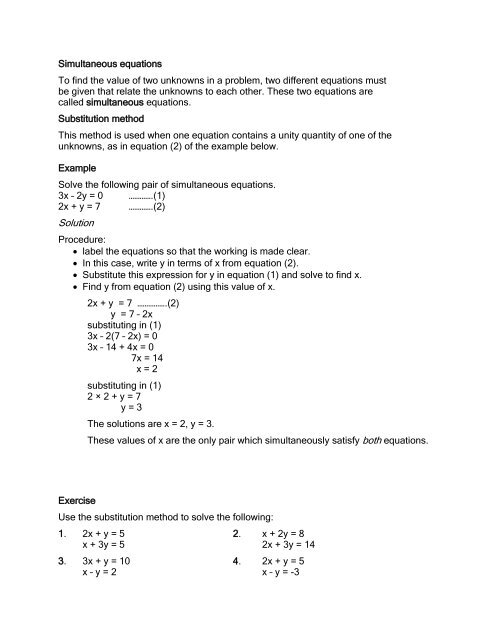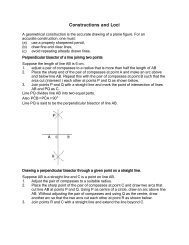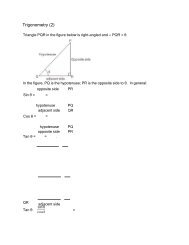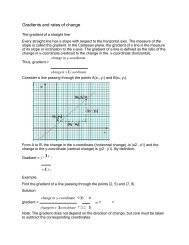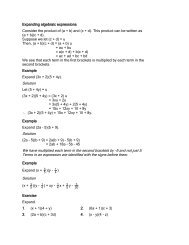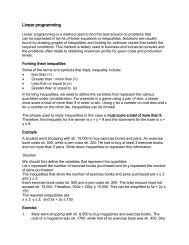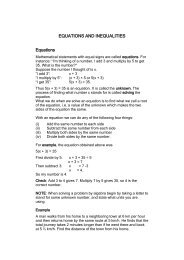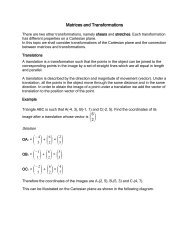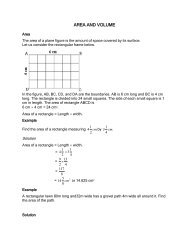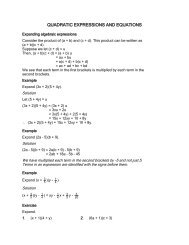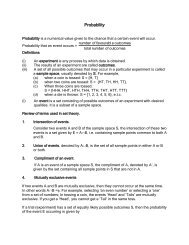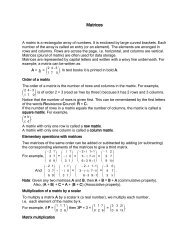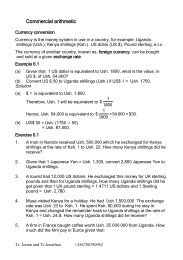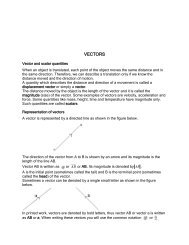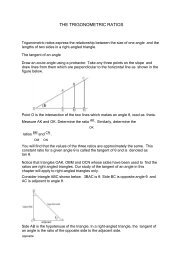J19
Create successful ePaper yourself
Turn your PDF publications into a flip-book with our unique Google optimized e-Paper software.
Simultaneous equations<br />
To find the value of two unknowns in a problem, two different equations must<br />
be given that relate the unknowns to each other. These two equations are<br />
called simultaneous equations.<br />
Substitution method<br />
This method is used when one equation contains a unity quantity of one of the<br />
unknowns, as in equation (2) of the example below.<br />
Example<br />
Solve the following pair of simultaneous equations.<br />
3x – 2y = 0 ………….(1)<br />
2x + y = 7 ………….(2)<br />
Solution<br />
Procedure:<br />
label the equations so that the working is made clear.<br />
In this case, write y in terms of x from equation (2).<br />
Substitute this expression for y in equation (1) and solve to find x.<br />
Find y from equation (2) using this value of x.<br />
2x + y = 7 …………….(2)<br />
y = 7 – 2x<br />
substituting in (1)<br />
3x – 2(7 – 2x) = 0<br />
3x – 14 + 4x = 0<br />
7x = 14<br />
x = 2<br />
substituting in (1)<br />
2 × 2 + y = 7<br />
y = 3<br />
The solutions are x = 2, y = 3.<br />
These values of x are the only pair which simultaneously satisfy both equations.<br />
Exercise<br />
Use the substitution method to solve the following:<br />
1. 2x + y = 5 2. x + 2y = 8<br />
x + 3y = 5 2x + 3y = 14<br />
3. 3x + y = 10 4. 2x + y = 5<br />
x – y = 2 x – y = -3
5. 4x + y = 14 6. x + 2y = 1<br />
X + 5y = 13 2x + 3y = 4<br />
7. 2x + y = 5 8. 2x + y = 13<br />
3x – 2y = 4 5x – 4y = 13<br />
9. 7x + 2y = 19 10. b – a = -5<br />
x – y = 4 a + b = -1<br />
11. a + 4b = 6 12. a + b = 4<br />
8b – a = -3 2a + b = 5<br />
13.<br />
1<br />
3m = 2n - 6<br />
2<br />
14. 2w + 3x – 13 = 0<br />
4m + n = 6 x + 5w – 13 = 0<br />
15. x + 2(y – 6) = 0 16. 2x = 4 + z<br />
3x + 4y = 30 6x – 5z = 18<br />
17. 3m – n = 5 18. 5c – d – 11 = 0<br />
2m + 5n = 7 4d + 3c = -5<br />
Elimination method<br />
Use this method when the first method is unsuitable (some prefer to use it for<br />
every question)<br />
procedure<br />
<br />
<br />
<br />
<br />
Example<br />
Label the equations so that the working is made clear.<br />
Choose an unknown in one of the equations and multiply the equations by a factor<br />
or factors so that this unknown has the same coefficient in both equations.<br />
Eliminate this unknown from the two equations by subtracting (or adding) the two<br />
equations , depending on whether the equal coefficients have like or opposite<br />
signs. Then solve for the remaining unknown.<br />
Substitute in the first equation and solve for the eliminated unknown.<br />
Solve the simultaneous equations:<br />
x+ 2y = 8; 2x + 3y = 14<br />
solution<br />
Let: x + 2y = 8 …………………..(i) and 2x + 3y = 14 ……………….(ii)<br />
Multiplying equation (i) by 2 gives,<br />
2x + 4y = 16 ………………..(iii)<br />
2x + 3y = 14 …………………(ii)<br />
Since the equal coefficients (of x) are both positive, we subtract (ii) from (iii), to get<br />
4y – 3y = 16 – 14<br />
y = 2<br />
substituting for y in (i) gives<br />
x + 2(2) = 8<br />
x + 4 = 8
x = 8 – 4 = 4<br />
The solutions are x = 4 and y = 2.<br />
Example<br />
Solve: 2x + 3y = 5 …………….(i)<br />
5x – 2y = -16 …………… (ii)<br />
Solution<br />
(i) × 2 4x + 6y = 10 ……………………….(iii)<br />
(ii) × 3 15x – 6y = -48 ……………………… (iv)<br />
Since the equal coefficients (of y) have opposite signs, we add the equations.<br />
That is, (iii) + (iv) gives<br />
19x = -38<br />
x = -2<br />
substituting for y in either equation (i) or (ii),<br />
2(-2) + 3y = 5, using equation (i)<br />
-4 + 3y = 5<br />
3y = 9<br />
y = 3<br />
The solutions are x = -2, y = 3.<br />
Exercise<br />
Use the elimination method to solve the following:<br />
1. 2x + 5y = 24 2. 5x + 2y = 13<br />
42 + 3y = 20 2x + 6y = 26<br />
3. 3x + y = 11 4. x + 2y = 17<br />
9x + 2y = 28 8x + 3y = 45<br />
5. 3x + 2y = 19 6. 2a + 3b = 9<br />
x+ 8y = 21 4a + b = 13<br />
7. 2x + 3y = 23 8. 3x + 8y = 27<br />
3x + 4y = 15 4x + 3y = 13<br />
9. 2x + 7y = 17 10. 5x + 3y = 23<br />
5x + 3y = -1 2x + 4y = 12<br />
11. 7x + 5y = 32 12. 3x + 2y = 4<br />
3x + 4y = 23 4x + 5y = 10<br />
13. 3x + 2y = 11 14. 3x + 2y = 7<br />
2x – 2 = -3 2x – 3y = -4<br />
15. x + 2y = -4 16. 5x – 7y = 27<br />
3x – y = 9 3x – 4y = 16<br />
17. 3x – 2y = 7 18. x – y = -1<br />
4x + y = 13 2x – y = 0
19. y – x = -1 20. x – 3y = -5<br />
3x – y = 5 2y + 3x + 4 = 0<br />
21. x + 3y – 7 = 0 22. 3a – b = 9<br />
2y – x – 3 = 0 2a + 2b = 14<br />
23. x + 2y = 4 24. 2x – y = 5<br />
1<br />
x y<br />
3x + y = 9<br />
2<br />
+ = 2<br />
4 3<br />
25. 3x – y = 17 26. 3x – 2y = 5<br />
x y<br />
2x y 7<br />
+ =0<br />
+ =<br />
5 2<br />
3 2 9<br />
27. 2x = 11 - y 28. 4x – 0.5y = 12.5<br />
x y<br />
=1<br />
5 4<br />
3x + 0.8y = 8.2<br />
29. 0.4x + 3y = 2.6 30. -3c + 4d = 4<br />
x – 2y = 4.6 9c – 2d = 3<br />
Graphical solution<br />
This method involves drawing the graphs of the given equations on the same coordinate<br />
axes. The coordinates of the point of intersection of these lines satisfy both equations<br />
and hence will be the solution to the simultaneous equations. Since two lines can only<br />
intersect in at most one point, there will be at most one pair of solutions to two<br />
simultaneous linear equations<br />
Example<br />
Solve the following pair of simultaneous equations using graphical method.<br />
3x + y = 6, x – y = 2<br />
Solution:<br />
3x + y = 6 x – y = 2<br />
x 0 1 3<br />
y 6 3 -3<br />
x 0 4 -2<br />
y -2 2 -4
Point of intersection (2, 0) is the only ordered pair which satisfies both equations, i.e. (2,<br />
0) lies on both lines.<br />
Therefore, the solutions are x = 2, y = 0<br />
Problem solving involving simultaneous equations.<br />
Many problems in everyday life involve more than one unknown quantity and<br />
simultaneous equations can often be used to find the required values of these<br />
quantities.<br />
Firstly, the unknown quantities must be given appropriate pronumerals. Then the<br />
information is translated into equations. If there are two unknowns, there must be two<br />
pieces of information leading to two equations before the problem can be solved. Since<br />
the problem is originally in words, the algebraic solution must be translated back into<br />
words to give the final answer.<br />
Example<br />
The sum of two numbers is 20 and their difference is 2. Find the numbers.<br />
Solution<br />
Let the larger number be x and the smaller number be y. Then<br />
x + y = 20 . . . . . .(i)<br />
x – y = 2 . . . . . . (ii)<br />
To eliminate y, (i) + (ii)<br />
2x = 22<br />
x = 11<br />
Substitute x= 11 into equation (i) to find y<br />
11 + y = 20<br />
y = 9<br />
So the numbers are 11 and 9.
Example<br />
The total cost of tickets to a show for 2 adults and 3 children is sh. 16,000 whilst the cost<br />
for 3 adults and 2 children is sh. 19,000. Find the cost of an adult ticket and of a child’s<br />
ticket.<br />
Solution<br />
Let the cost of an adult’s ticket be sh. A<br />
Let the cost of a child’s ticket be sh.c<br />
2a + 3c = 16,000 ………….(i)<br />
3a + 2c = 19,000 …………..(ii)<br />
To eliminate c:<br />
2 × (i) – 3 × (ii) ⇒ -5a = -25,000<br />
a = 5,000<br />
substitute a = 5,000 in (i)<br />
10,000 + 3c = 16,000<br />
3c = 6,000<br />
c = 2,000<br />
So an adult ticket costs sh. 5,000 and a child’s ticket costs sh. 2,000.<br />
Exercise<br />
Solve each problem by forming a pair of simultaneous equations:<br />
1. Find two numbers with a sum of 15 and a difference of 4.<br />
2. Twice one number added to three times another number gives 21. Find the<br />
numbers, if the difference between them is 3<br />
3. The line, with equation y + ax = c, passes through the points (1, 5) and<br />
(3, 1). Find a and c<br />
4. A cyclist completes a journey of 500 m in 22 seconds, part of the way at 10 m/s<br />
and the remainder at 50 m/s. How far does she travel at each speed<br />
5. A bag contains forty coins, all of them either Sh. 200 or sh. 500 coins. If the value<br />
of the money in the bag is sh. 10,500, find the number of each kind.<br />
6. Thirty tickets were sold for a concert, some at sh. 10,000 and the rest at sh. 5,000.<br />
If the total raised was sh. 800,000, how many had the cheaper tickets?<br />
7. The wage bill for five men and six women workers is sh. 6,700,000, while the bill<br />
for eight men and three women is sh. 6,100,000. Find the wage for a man and for<br />
a woman.<br />
8. The denominator of a fraction is 2 more than the numerator. If both denominator<br />
and numerator are increased by 1 the fraction becomes 3<br />
2 . Find the original<br />
fraction.
9. Find two numbers where three times the smaller number exceeds the larger<br />
number by 5 and the sum of the numbers is 11.<br />
10. A straight line passes through the points (2, 4) and (-1, -5). Find its equation.<br />
11. A wallet containing sh. 40,000 has three times as many sh.1,000 notes as sh.<br />
5,000 notes. Find the number of each kind.<br />
12. At the present time a man is four times as old as his son. Six years ago he was 10<br />
times as old. Find their present ages.<br />
Simultaneous equations – one linear and one quadratic<br />
These are equations which involve two unknowns. One equation includes terms of the<br />
second degree such as x 2 , xy and y 2 and the other equation is of the first degree, i.e.<br />
linear.<br />
The usual method of solving such simultaneous equations is to use the linear<br />
equation to eliminate one of the unknowns from the quadratic equation.<br />
Example<br />
Solve the simultaneous equations:<br />
x+ y = 0 …………………….(i)<br />
y 2 – xy = 8 ………………….(ii)<br />
From x + y = 0, we get x = -y<br />
Substituting x = -y in (ii), we get<br />
y 2 – (-y)y = 8<br />
y 2 + y 2 = 8<br />
2y 2 = 8<br />
y 2 = 4<br />
y = +2 or -2<br />
To find x substitute y = 2 and y = -2 in x + y = 0, or x = -y<br />
When y = 2, x = -y = -2<br />
When x = -2, x = -y = +2<br />
The solutions are:<br />
When x = +2, y = -2 and when x = -2, y = +2<br />
The solutions should be arranged in corresponding pairs.<br />
Note: Before starting to solve the equations, look at them carefully and see which is the<br />
easier unknown to eliminate. For example, in<br />
3x – y = 8 and 3x 2 – xy + 9 = y 2 , it is easier to eliminate y from<br />
3x – y = 8, giving y = y = 3x – 8<br />
8 + y<br />
For x, we have x = which involves a fraction.<br />
3<br />
Example
Solve the equations: x + y = 19 , xy = 84.<br />
(You can eliminate either x or y. It makes no difference).<br />
From x + y= 19, we have y = 19 – x<br />
Substituting in equation xy = 84, we get<br />
x (19 – x) = 84<br />
19x – x 2 = 84<br />
x 2 – 19x + 84 = 0<br />
(x – 12)(x – 7) = 0<br />
Either x = 12 or x = 7.<br />
Substitute values of x in x + y = 19, to get<br />
When x = 12, 12 + y = 19 or y = 7<br />
When x = 7, 7 + y = 19 or y = 12.<br />
Solutions are: when x = 12, y = 7 and when x = 7, y = 12.<br />
Exercise<br />
Solve the following simultaneous equations:<br />
1. 2x – y = 0 2. x + y = 8<br />
x 2 + xy = 75 xy = 15<br />
3. x + y = 0 4. y 2 = 8x<br />
x 2 – xy + y 2 = 12 y = 3x – 16<br />
5. x – 2y = 2 6. 3x + y = 6<br />
Xy = 12 2x 2 – x = y + 6<br />
7. x + y = 7 8. p + 2q = 15<br />
x 2 + y 2 = 25 pq = 25<br />
9. x + y = 3 10. 2x – y = 2<br />
2x + 2y = 3xy x 2 + y 2 = 89<br />
11. A rectangle is (x+ 3) cm long and y cm wide. The perimeter of the rectangle is 25<br />
cm. The area of the rectangle is 22.5 cm 2 .<br />
(a) Form and solve the simultaneous equations in x and y.<br />
(b) Write down to 2 d.p., the length and width of the rectangle.<br />
12. The longest side of a right angled triangle is 25 cm and the two sides containing<br />
the right angle are x cm and y cm. If one of the shorter sides exceeds the other by<br />
17 cm. obtain two equations in x and y and solve them.


